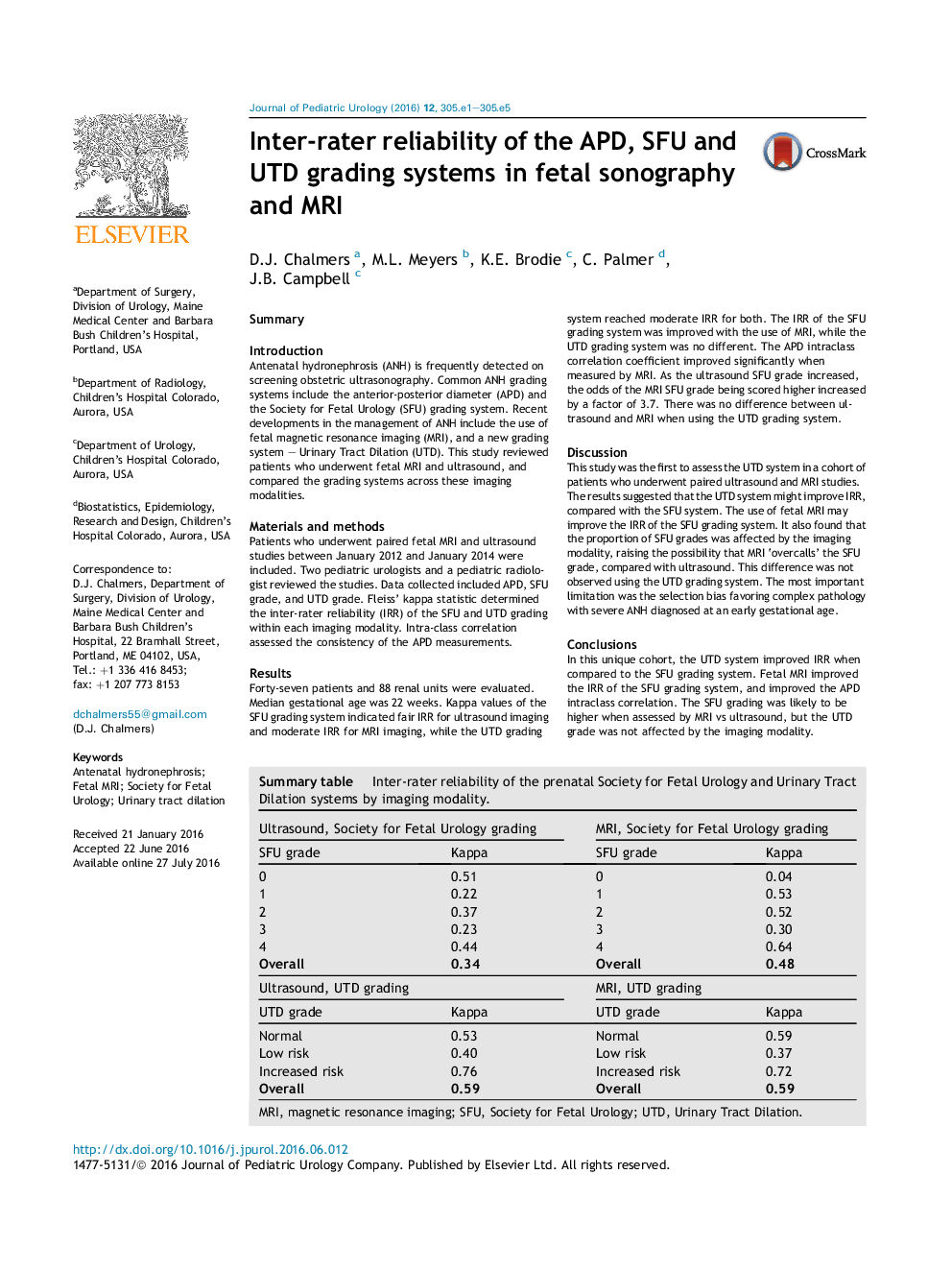| کد مقاله | کد نشریه | سال انتشار | مقاله انگلیسی | نسخه تمام متن |
|---|---|---|---|---|
| 5718778 | 1411257 | 2016 | 5 صفحه PDF | دانلود رایگان |

SummaryIntroductionAntenatal hydronephrosis (ANH) is frequently detected on screening obstetric ultrasonography. Common ANH grading systems include the anterior-posterior diameter (APD) and the Society for Fetal Urology (SFU) grading system. Recent developments in the management of ANH include the use of fetal magnetic resonance imaging (MRI), and a new grading system - Urinary Tract Dilation (UTD). This study reviewed patients who underwent fetal MRI and ultrasound, and compared the grading systems across these imaging modalities.Materials and methodsPatients who underwent paired fetal MRI and ultrasound studies between January 2012 and January 2014 were included. Two pediatric urologists and a pediatric radiologist reviewed the studies. Data collected included APD, SFU grade, and UTD grade. Fleiss' kappa statistic determined the inter-rater reliability (IRR) of the SFU and UTD grading within each imaging modality. Intra-class correlation assessed the consistency of the APD measurements.ResultsForty-seven patients and 88 renal units were evaluated. Median gestational age was 22 weeks. Kappa values of the SFU grading system indicated fair IRR for ultrasound imaging and moderate IRR for MRI imaging, while the UTD grading system reached moderate IRR for both. The IRR of the SFU grading system was improved with the use of MRI, while the UTD grading system was no different. The APD intraclass correlation coefficient improved significantly when measured by MRI. As the ultrasound SFU grade increased, the odds of the MRI SFU grade being scored higher increased by a factor of 3.7. There was no difference between ultrasound and MRI when using the UTD grading system.DiscussionThis study was the first to assess the UTD system in a cohort of patients who underwent paired ultrasound and MRI studies. The results suggested that the UTD system might improve IRR, compared with the SFU system. The use of fetal MRI may improve the IRR of the SFU grading system. It also found that the proportion of SFU grades was affected by the imaging modality, raising the possibility that MRI 'overcalls' the SFU grade, compared with ultrasound. This difference was not observed using the UTD grading system. The most important limitation was the selection bias favoring complex pathology with severe ANH diagnosed at an early gestational age.ConclusionsIn this unique cohort, the UTD system improved IRR when compared to the SFU grading system. Fetal MRI improved the IRR of the SFU grading system, and improved the APD intraclass correlation. The SFU grading was likely to be higher when assessed by MRI vs ultrasound, but the UTD grade was not affected by the imaging modality.Summary table. Inter-rater reliability of the prenatal Society for Fetal Urology and Urinary Tract Dilation systems by imaging modality.Ultrasound, Society for Fetal Urology gradingMRI, Society for Fetal Urology gradingSFU gradeKappaSFU gradeKappa00.5100.0410.2210.5320.3720.5230.2330.3040.4440.64Overall0.34Overall0.48Ultrasound, UTD gradingMRI, UTD gradingUTD gradeKappaUTD gradeKappaNormal0.53Normal0.59Low risk0.40Low risk0.37Increased risk0.76Increased risk0.72Overall0.59Overall0.59MRI, magnetic resonance imaging; SFU, Society for Fetal Urology; UTD, Urinary Tract Dilation.
Journal: Journal of Pediatric Urology - Volume 12, Issue 5, October 2016, Pages 305.e1-305.e5